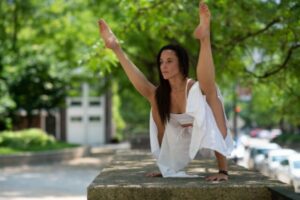How did you get into yoga? What aspect of yoga got you on the mat in the beginning?
I’m originally from Guatemala, and came to Chicago for the first time as an Au Pair back in 2004. I lived with a family for one year to experience a different culture, while taking care of their two beautiful daughters. My host-mom was a yoga teacher, and she got me into it. I can’t say what aspect of it kept me coming back to the mat, I just really liked how I felt during and after, but as I think about it now, it was probably the need for a time to myself and I knew I could get that with every practice.
What would you consider your yoga style and who were a few teachers that influenced you the most? Can you talk about the Ashtanga practice as well and about your experience teaching this style?
I practice and teach Ashtanga Yoga. In the beginning Ashtanga was not what I did, my first teacher was Marty Clemons (my host-mom), and she helped me build the base of my practice. Later, I practiced with Jim Bennitt, who still has a big influence in the way I practice and teach, even though he doesn’t teach Ashtanga yoga. Once I discovered Ashtanga, Kino MacGregor, Daylene Christensen, and Todd Boman were the teachers I would go to. And as of now, Richard Freeman is the teacher that I consider “my favorite”. There are a lot of teachers out there that I’ve learned from so it’s hard to choose, but I would say these are the ones that have influenced me the most.
Ashtanga Yoga is a system of postures connected by the breath. It combines sequential, flowing movements with focused internal awareness. Through self practice, and self observation a non-judgmental attitude is cultivated. This peaceful quality is manifested by focusing on the flowing nature of the breath. We use the breath as a vehicle by which the body and mind are observed, and connected. The traditional way of practicing Ashtanga Yoga is in a Mysore setting. There are also Led Primary classes.
There are 6 sequences. Everyone starts with the first one, or Primary series, and advances sequentially through each series, pose by pose.
The Mysore self-practice, is unique compared to other asana classes. You practice at your own pace, without interruption. There is a teacher in the room, walking around, giving adjustments, and teaching students what to do according to the needs of their bodies. You simply do your practice, receive certain adjustments and wait for the next posture your teacher will give you.
I think Ashtanga is a very intelligent sequence, and there are ways of making it work for everyone regardless of body type, injury, or specific need. There are always modifications, and variations that can be done staying within the frame of what the traditional way of practicing is, which makes it accessible to anyone. One of the most enjoyable aspects about teaching this style, is that I can easily see my students’ progress because the sequence is always the same. I have witnessed incredible transformations, and healing in many students, and that’s one of many reasons for me to keep sharing this practice.
Why do you love teaching at yogaview?
It has one of the best communities I’ve encountered out of the yoga studios I’ve been with. The owners, managers, teachers, and staff are very supportive, and the students, very committed. Everyone is always warm and welcoming.
Within the 8 limbs of yoga, the experience of Samadhi is often described as the top rung of the ladder. It’s considered by many to be indescribable, yet it is often described as such and more. Can you please describe your personal experience of this state or what the concept represents to you?
After 13 years of practice and extensive study, I still don’t believe I’ve attained Samadhi by the formal definition, but I hope to one day realize that state of peace! The concept resonates with me most as a guide for life, day to day. I interpret Samadhi as moments of real clarity and equanimity. I think it’s very difficult to be cognizant of this, but I believe through the practice of yoga we can develop the habit of being more aware of our detrimental patterns of thought and behavior. Once we become aware of those patterns, we can begin to change them and maybe then, we can attain more peace and clarity.
What was one of the funniest or most humbling moments you’ve had while teaching a class?
I’ve had a lot of those, one that comes to mind right now is when I asked someone, “how far along are you?”, and she wasn’t pregnant! :/
Definitely humbling. Taught me not to make assumptions based on appearances and say it out loud! Funny now, not at the time, especially to her I guess.
If there was one spiritual teacher or guru that you would desire to study under (dead or alive) who would it be?
Yoda!
What is your favorite non yoga activity?
I have too many but I’ll mention a couple… I love working in any creative project I can get my hands into, baking, hiking and spending time in nature. I’m also very organized, so you’ll find me organizing and re-organizing things, and I actually enjoy that.

